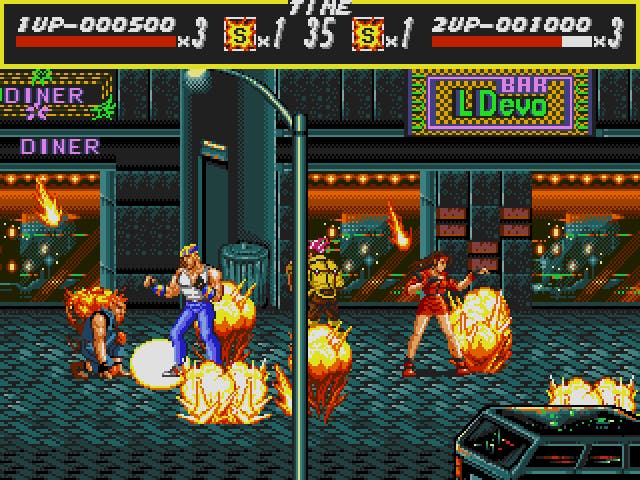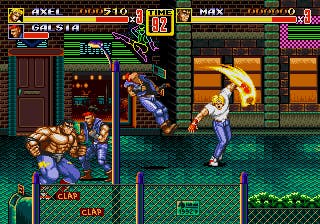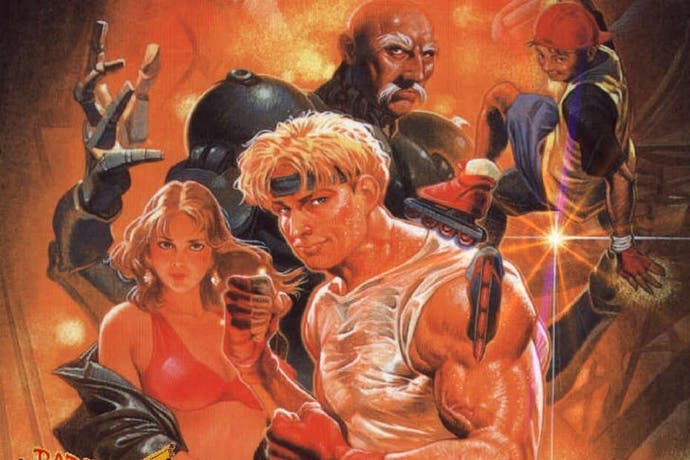Streets of Rage was much more than a Final Fight clone
Bare Knuckle sandwich - a look back at Sega's 16-bit series.
Back in the days when arcade conversions were often enough to make or break a home console, the earth-shattering news that Nintendo had secured a port of Capcom's Final Fight for its soon-to-be-released Super Famicom sent shockwaves through playgrounds all over the globe. In this pre-Street Fighter 2 world, Final Fight was the biggest ticket in town; a side-scrolling brawler in the tradition of Renegade and Double Dragon, it boasted massive character sprites, a wide repertoire of attack moves and instantly accessible gameplay. Nestled neatly within Nintendo's 16-bit launch line-up, it was a definite system seller - despite the fact that cartridge memory constraints meant the two-player mode, third character Guy and an entire level were left on the cutting room floor.
While Sega fans would eventually get a port of Final Fight for the Mega CD three years later, back in 1990 the news was nothing short of devastating. The Mega Drive was famed for its superlative arcade ports - which included Capcom favourites Strider and Ghouls 'n' Ghosts, both skilfully converted by Sega itself under license - and prior to the announcement of the Super Famicom edition, there were idle rumours that Final Fight was headed to Sega's console under a similar arrangement. When that didn't happen though, rather than admit defeat in the battle of the side-scrolling fighter, Sega did something which has been a common practice in the video game industry since its very inception: it plagiarised.
Streets of Rage - or Bare Knuckle, to use its Japanese moniker - was as close as Mega Drive owners were ever going to get to Final Fight at that point in time. One of the three playable characters - Axel Stone - bares more than a passing resemblance to Final Fight's hero Cody, right down to the white T-shirt, tight stonewash jeans and sporty sneakers. The core mechanics are also very similar; both games expand on the template laid down by Double Dragon and focus on combination attacks and grapple moves, the latter of which can be finished off with a throw - perfect for crowd control as the hurled assailant becomes a wrecking ball which can be used to take down other enemies.

However, with the development team responsible for the superlative Revenge of Shinobi behind the wheel, Streets of Rage was never likely to end up as just a slavish clone. It may take a healthy amount of inspiration from Capcom's 1989 coin-op - a game which itself built upon the groundwork laid down by the likes of Technos in the '80s - but it brings its own ideas to the table as well. Grapples don't just involve knees to the groin and throws - you can vault over your stunned opponent before delivering a head-crunching suplex onto cold, unremitting concrete. In co-op play, players can grapple one another and unleash a special airborne attack, and tapping the A button results in one of the most unintentionally amusing special attacks in the history of games: a police car rolls into view and delivers a shower of napalm death from above, an offensive move which decimates your enemies but somehow manages to leave you entirely unscathed. Still, it looks plenty cool.
Given the popularity of games that involve repeatedly punching people in and around the face, it's perhaps unsurprising that Streets of Rage found a receptive audience on the Mega Drive. Playgrounds erupted anew with heated arguments about format dominance - Sega fans had a side-scrolling fighter with a proper two-player mode and three characters, while Nintendo owners continued to cite the better-known Capcom release and its massive, screen-filling sprites. There was still room for doubt, but this was effectively removed when Sega launched Streets of Rage 2 in 1992. UK residents may still be able to recall that awesome moment during the first episode of GamesMaster rival Bad Influence when a grinning Andy Crane gleefully revealed hitherto unseen footage of the game in full, pugilistic flow. The effect was dramatic, making the sequel one of the most eagerly anticipated releases in the history of Sega's console.

Played today, Streets of Rage 2 has lost none of its ability to entertain and delight. It's a marked improvement over the already brilliant forerunner; the sprites are larger, more detailed and boast superior animation, while the roster of playable characters has been increased by one. Each fighter has the usual combos and grapple attacks, but this time around additional special moves take the place of the ranged assault of the trigger-happy police force. Tapping A on its own unleashes a 360-degree attack that depletes your health bar slightly, just like in Final Fight - but combining the same button with a direction executes a totally different - and more focused - special move. Double-tapping forward and B delivers yet another special offensive option, this time one that doesn't incur a stamina penalty.
Factor in a much wider degree of variety between characters (all three fighters in the original effectively had the same movesets) and you've got a game which iterates successfully on an already excellent concept. Streets of Rage 2 is widely acknowledged as one of the finest examples of the genre, if not the best side-scrolling brawler of all time. Sega's triumph was made all the more sweet by the fact that Capcom's SNES-exclusive Final Fight sequel - released around the same time - was a crushing disappointment, comparatively speaking.
By the time Streets of Rage 3 appeared in 1994, it could be said that the side-scroller's status as a system-seller was coming to an end. Capcom's Street Fighter 2 had established one-on-one combat games as the de facto genre of choice for arcade players, and just as before, wily old Nintendo had secured the first domestic conversion for its own hardware. History would repeat itself; Sega got sloppy seconds with Street Fighter 2: Special Champion Edition a year after the port of the SNES original, but the damage was effectively done - not just for Sega, but for games like Streets of Rage and Final Fight in general. Thrill-seeking players now craved the competitive edge which only titles like Street Fighter 2 could deliver; rather than working cooperatively with their friends, they preferred to test their mettle in a one-on-one contest featuring magical fireballs and spinning piledrivers.
As a result, Streets of Rage 3 perhaps didn't get the plaudits it deserved when it was first released. Its graphical similarity to the second game didn't help; while the 24 megabit cart ensures that it's certainly a looker, it doesn't deliver the same dramatic visual shift witnessed between the releases of the first two instalments. Still, the combat engine has been cleverly augmented, with additional special moves accessed more easily using Sega's excellent six-button control pad, released in the wake of the Mega Drive Street Fighter 2 port. So complex is the game's selection of moves that the Japanese edition of title was issued with a fold-out quick-reference sheet, allowing players to more easily familiarise themselves with each character's repertoire.
On paper, the third instalment is clearly the best of the trilogy, yet it gets talked about a lot less than its immediate forerunner. Perhaps it was simply a matter of timing - Sega's 16-bit console was beginning to show its age, and the Saturn and PlayStation were just around the corner - but the reaction to Streets of Rage 3 was curiously muted when compared to the rapturous welcome that greeted its predecessor.

It would be totally remiss - not to mention downright rude - to speak about the Streets of Rage trilogy without touching upon Yuzo Koshiro's amazing work on the soundtrack which accompanies the series. While modern players will know him best for the superlative audio witnessed in Atlus' Etrian Odyssey range of DS and 3DS role-playing titles, Koshiro arguably cemented his reputation on Sega's hardware. The music created for the first Streets of Rage still sounds effortlessly cool even by today's standards, and in the console wars of the early '90s it gave long-suffering Mega Drive owners something to feel smug about when faced with their Nintendo-loving mates - all of whom will have wasted no time in pointing out the aural superiority of the SNES.
Streets of Rage 2 was blessed with just as appealing a soundtrack, and while the third game's frantic and largely experimental jungle music divided fans at the time (Koshiro developed a process which randomly generated tracks, a method which has been favoured by cult dance acts like Aphex Twin), it has aged better than many will have anticipated back in 1994. All three soundtracks were wildly ahead of their respective times, and constitute some of the finest audio ever to be generated by the Mega Drive's oft-derided Yamaha YM2612 sound chip.
With side-scrollers falling rapidly out of favour, Sega held back on a fourth Streets of Rage outing. Core Design was commissioned to produce a 3D Streets of Rage 4 for the 32-bit Saturn, which ironically would eventually see the light of day under the name Fighting Force on the Saturn's rivals, the Sony PlayStation and Nintendo 64. Since then, the list of abortive attempts to resurrect the series has grown at an alarming rate. Japanese studio Ancient - founded by Koshiro himself - prototyped a 3D Streets of Rage for the Sega Dreamcast with an optional first-person perspective, but it would sadly never see the light of day - an apparent causality of Sega's increasingly cautious approach during this turbulent period. Now-defunct Swedish studio Grin - responsible for rebooting Capcom's Bionic Commando - was apparently working on a new entry which was abandoned when the company folded in 2009, while Backbone Entertainment - the team behind the Sega Vintage Collection on PlayStation Network and Xbox Live Arcade - pitched a sequel a couple of years ago along with another for stablemate ESWAT, but neither came to anything. Finally, there was an effort by Crackdown 2 creator Ruffian Games to update the concept - another project which never got past the prototype stage.
Sega hasn't entirely forgotten about the franchise - the original Mega Drive game was convincingly updated last year by emulation experts M2 on the 3DS as part of Sega's 3D Classics range, adding stereoscopic 3D support and an amusing mode where enemies can be dispatched with a single punch, Fist of the North Star-style. However, outside of incredible fan projects like the highly polished Streets of Rage Remake, the future of Sega's side-scrolling series remains uncertain. Despite paying lip service to fans with the 3DS port, Sega today appears to be largely disinterested in mining its previously profitable back catalogue.
Of course, there's the very important question of how a franchise set in what is now a very unfashionable genre could possibly be updated for a modern audience; Capcom's effort to revive its famous side-scrolling fighting brand in the PlayStation 2 title Final Fight Streetwise was an unmitigated disaster, possibly illustrating that some of gaming's most esteemed names are destined to remain locked away in the past. Perhaps that is why Streets of Rage inspires such a tremendous degree of affection from retro enthusiasts; unlike its inspiration and long-time rival Final Fight, it didn't outstay its welcome with needless sequels. Or maybe it's because Sega's smack-happy lineage arguably represents the absolute zenith of the genre, and any subsequent releases would merely be gilding an already exquisite lily.


